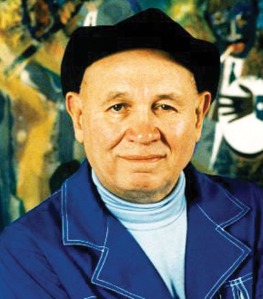“In Bearden you’ve got all these pieces. There’s an eye here, a head over there, a huge oversized hand on a small body. It’s like that with me. I’ve got all these images, and the point is how I put them together, the relationships between them that counts.”
Romare Bearden (1911–1988) grew up at the height of New York City’s Harlem Renaissance and was influenced by such family friends as Langston Hughes, W.E.B. DuBois and Duke Ellington. Although he was a successful painter and dedicated civil rights activist, Bearden is best known for his vibrant collages fusing depictions of Harlem life with images and impressions of the American South. This sense of a cultural narrative spanning generations and expressing the African-American experience is also a hallmark of Wilson’s plays.
 One black way of confronting the conundrum of life with passion is through ritual, and it is on this ground that Wilson met Romare Bearden, the African American artist best known for his collages of black life created during the 1960s and 1970s. Wilson holds Bearden in reverential esteem, for Bearden has not only served as the explicit inspiration for at least two of Wilson’s plays–Joe Turner and The Piano Lesson—Bearden also serves Wilson as a kind of father-figure (both grew up in Pittsburgh), a personification of the ideal for a black artist. Indeed, Wilson has adopted Bearden’s credo as his own: “I try to explore, in terms of the life I know best, those things which are common to all cultures” (Wilson’s “How to Write a Play).
One black way of confronting the conundrum of life with passion is through ritual, and it is on this ground that Wilson met Romare Bearden, the African American artist best known for his collages of black life created during the 1960s and 1970s. Wilson holds Bearden in reverential esteem, for Bearden has not only served as the explicit inspiration for at least two of Wilson’s plays–Joe Turner and The Piano Lesson—Bearden also serves Wilson as a kind of father-figure (both grew up in Pittsburgh), a personification of the ideal for a black artist. Indeed, Wilson has adopted Bearden’s credo as his own: “I try to explore, in terms of the life I know best, those things which are common to all cultures” (Wilson’s “How to Write a Play).
The life Bearden knew best was characterized by The Prevelance of Ritual, the title of a series of collages that were collected in a volume in 1971, a volume which had a catalyzing effect on Wilson. Wilson describes the moment as a young struggling poet when he first encountered Bearden:
“[The Prevelance of Ritual” lay open on the table…I looked. What for me had been so difficult, Bearden made seem so simple, so easy. What I saw was black life presented on its own terms, on a grand and epic scale, with all its richness and fullness, in a language that was vibrant and which, made attendant in everyday life, ennobled it, affirmed its value, and exalted its presence…I was looking at myself in ways I hadn’t thought of before and have never ceased to think of it since.” (Payne)
Bearden offered Wilson a new visual language that created a world populated by conjure women, trains, guitar players, birds, masked figures, and the rituals of baptisms, funerals, dinners, parades. Wilson was of course impressed by the black experience Bearden represented, but he was equally interested in his mode of representation. Wilson volunteers the creation story of this new black form.
“One day in [1963] Bearden and some of his colleagues had arranged to work together on a collaborative work–it was supposed to be a collage of black life at that time–but when it came time to actually do it, Bearden was the only one who showed up. So he went ahead and just started doing it on his own.” (Rocha 31-32)
Bearden “riffed” on the quintessentially twentieth-century language of collage, first introduced by Picasso in his Cubist experiments, to create a form capable of expressing what Ralph Ellison has called the “sharp breaks, leaps in consciousness, distortions, paradoxes, reversals, telescoping of time and Surreal blending of styles, values, hopes and dreams which characterize much Negro American history.” Wilson describes the structure of his own plays as having this collagist form (see above quote).